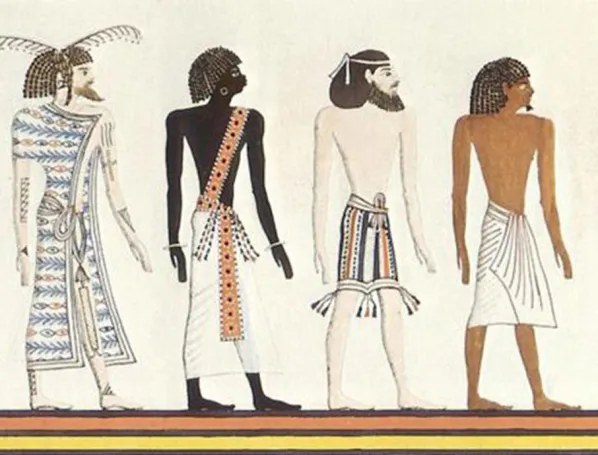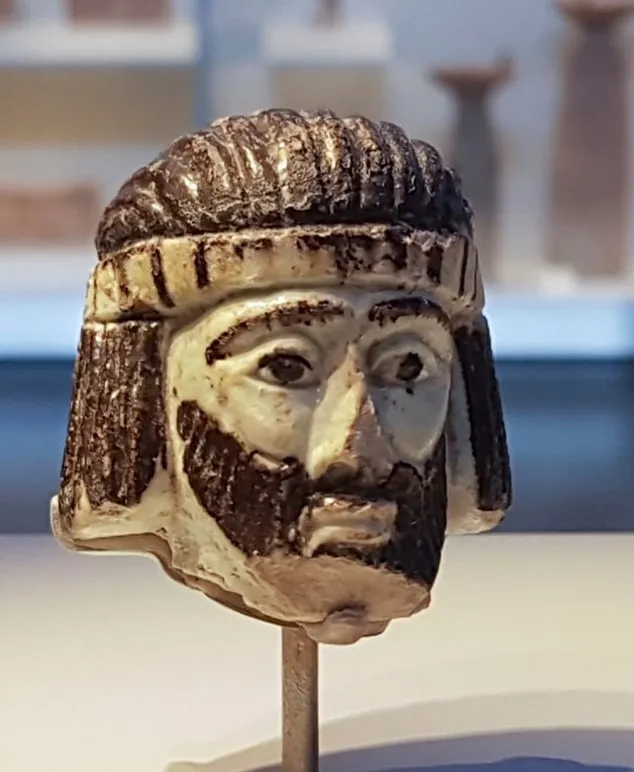February 17th, 2022
74. Did David have red hair?
Please explain why the word "hair" was added in 1 Samuel 16:12 in the EHV. The Hebrew word for hair (shear) is not in that verse. My understanding is that "ruddy" is the closest literal translation for admoni, which I didn't think included hair in the definition, but likely could be skin color. The Hebrew word is close to the words for red (adom) and Adam (adam) and ground (adamah). My guess is maybe you used the description of Esau in Genesis 25:25 to interpretively "add" in the word hair to describe David? The word ruddy makes me think of a Bedouin nomad, whereas "red hair" makes me think of a northern European from Scotland.
We can say that a description of David’s appearance is not “written in stone” or more precisely, it is not painted on stone in color as some pictures of ancient people are.
Plausible answers to the question “Did David have red hair are “No, Yes. Maybe. We don’t know.” Let us investigate to see if we can find which is most plausible.
The majority of translations reflect one of four options: 1) the term admoni does not refer to a natural physical trait of David but to a healthy look; 2) the word refers to a naturally reddish complexion; 3) the word refers to skin colored by the sun and wind, or perhaps blushing; 4) the word may include both a reddish complexion or freckles and red hair, which sometimes go together.
Perhaps the most common translation is “ruddy.” Two factors give us pause about this translation. Ruddy has something of an archaic sound to it. I do not recall ever hearing anyone called ruddy in live conversation, only in literature. Men with red hair and/or freckles are called Red or Rusty, not Rudd. The second factor is that the meaning of ruddy is unclear. This translation will not communicate clearly. It is non-committal. The dictionary I used as a student says ruddy refers to reddish skin color. On the other hand, a recent online word study says: “Ruddy is used to describe something that is reddish — like the color of red hair, tomatoes, or a friend's cheeks on a cold winter's day.” This definition leaves all the options open.
Before we go on to discuss some of the other options, we need to digress for a moment to discuss skin color in the ancient Near East. This issue is referred to in many ancient writings and in ancient art. Some Egyptian art reflects four basic types or “races”: relatively light Libyans/Berbers; black Nubians or Cushites; relatively light Asiatics/Canaanites; darker brown native Egyptians. Egyptians saw themselves as lighter than Nubians and darker than Asiatics.

This information must be used with caution since the coloration can be influenced by the modern reproducers of the paintings, but the general tendency is quite clear. It is supported by the following painting of itinerants from “Asia” who are pictured along with Egyptians. The relationship is the same as that above.

In the land of Canaan and Israel, people of many ethnic groups were present. Some people have Indo-European names. Black Cushites were present, often as mercenaries. If you met groups of Israelites, Canaanites, Jebusites, Girgashites, and Perezzites, could you distinguish them by their skin tone or hair and eye color, by their dress, by their first language, by their accent? We simply do not know. And the groups of course were not homogenous.

A statue of a king recently found in northern Israel has a relatively light skin color, though the skin color may reflect the color of the clay, more than a deliberate attempt to indicate skin tone, There is however a clear distinction between black beard and light skin. It is uncertain whether this is a picture of an Israelite or Aramean king, but it does not matter for our purposes since Israelites seem to have been similar in appearance. At any rate, there is evidence that Israelites in general were noticeably lighter than their neighbors to the south.
This has some relevance to the interpretation that the description of David refers to rosy cheeks or reddish skin. The Hebrew term for tanning seems to be black or dark not red. See Song of Songs 1:5-6. The term dark does not identify the woman’s race or ethnicity but her low social status. She is not one of the fine ladies who sit in the shade all day. She is tanned and dark because she must work in the hot sun all day.
In the case of David the trait admoni must be something quite distinctive that makes him stand out in a crowd. Would he be any more or less sun-kissed than his brothers? Would it be remarkable if his skin was redder than his brothers'? Red hair would be quite remarkable.
What about red hair? Is it possible? It definitely was present in the ancient Near East. The trait does seem more prevalent in the north Aegean area. Two ladies said to be red-heads were Helen of Troy and Cleopatra (perhaps chemically enhanced). Achilles and Alexander the Great were said to be redheads. Perhaps some of these identifications relate to the stereotype of redheads as strong willed. The same may be true of the portrayal of Adam and Eve and Mary Magdalene as redheads. In the case of Adam and Eve at least there is a slim shred of evidence. The claim that red is the original hair color on humanity is linked to the use of the roots adam and adamah in reference to Adam and Eve.
For Egypt the evidence for red hair is quite strong. Most interesting is the evidence for Ramses II. He was near 90 at death. His mummy’s white hair was died red, but microscopic inspection of the roots of Ramses II's hair and other analysis showed that the king’s hair originally was red, which suggests that he came from a family of redheads. (The common practice was to color grey hair the color it had been when you were young. Herod died his gray hair black.) There is also quite a bit of other evidence for red hair in Egypt.
(Though the Egyptians were not black, there were dynasties of black Nubian pharaohs, and the last dynasty was Macedonian.)
But is there any objective evidence related to Israelites? A first century tomb south of Jerusalem preserved skeletal remains of a Jewish male which preserved a sample of his hair. The color of the hair was “reddish.”
Red hair is reasonably well represented among today’s Jews. The Hebrew name for this is gingi, and they have a website devoted to them named Ginger Jews. But it seems that this trait tends to be concentrated among those known to have some northern European heritage, so we can’t put much weight on it. But just as little can we look at present-day inhabitants of the Middle East and think that they tell us much about the appearance of ancient Israelites.
It is also wrong to think of Israelites as having a homogenous appearance. They were a mixture of many ethnic lines. The well known ability of red hair to appear across racial lines may be illustrated by the case of Malcolm X, who hated his red hair and his nickname “Detroit Red.” It seems quite possible that his red hair was a heritage of Celtic genes from a slave owner. We should be careful about stereotypes and about assumptions about traits within certain groups.
But what about linguistic evidence? My Gesenius Hebrew Lexicon (Gesenius was a pioneer of modern Hebrew lexicons) gives the definition of admoni as “red, that is, red-haired, German rothaarig.” Other word studies, translations, and commentaries say the same, and there are Jewish traditions about David’s red hair. The problem with all of these is that they are very likely doing the same thing as we are doing—looking at the two cases we have and taking their best educated guess.
Admoni is a special word for which we have little evidence of usage. In the case of animals with red hair (the red heifer—Numbers 19:2), the adjective for red is used. That leaves us only the cases of Esau and Jacob as our resources. In the case of Esau (Genesis 25:25) the link with his hair is more strongly implied but is not explicit. The case of David has even less specificity.
It should be noted that translating admoni as red haired is not adding anything to the definition. It is simply attempting to define the word. Many words in other languages require more than one English word to translate them.
A Jewish Encyclopedia article about hair summarizes: The hair of the ancient Hebrews was generally black (comp. Cant. iv. 1, v. 11). Black hair was in any case considered beautiful, black being the general color, while light or blond hair was exceptional. David is designated as "admoni" = "ruddy" (I Sam. xvi. 12, xvii. 42), this expression being also applied to Esau's hair (Gen. xxv. 25).
So after considerable time looking at the evidence, what can we conclude about the answer to our original question “Did David have red hair?”
After considerable study we find that plausible answers to the question “Did David have red hair?” are “No, Yes, Maybe, and We don’t know.”
Option 1 “No” seems to be the most popular, often with a focus on either natural or weather-influenced complexion. The translation ruddy could also be listed as a “maybe” or “we don’t know” since the word is ambiguous. A major factor cited in favor of the answer “No” is the opinion that Jews of that time could not have had red hair, but this is based on assumption not evidence.
Answer 2 “Yes” is the most interesting answer, because it does not just parrot a common opinion, but digs into the issue. The EHV’s frequent practice is that when we are aware of questions or disputed issues, we try to dig into the issue and to call attention to the issue. By putting one view into the translation and another one into the notes, we invite readers to look at the issue. In this case, it would be easy to justify putting either view into either the text or the footnote. Intriguingly, the EHV’s answer to the question “Did David have red hair?” is “Yes, maybe, but we don’t know for sure.” Nor does anyone else.